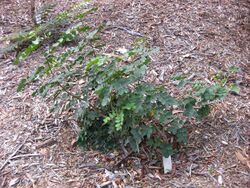Biology:Delonix pumila
| Delonix pumila | |
|---|---|

| |
| young Delonix pumila plant at the Mildred E. Mathias Botanical Garden in Los Angeles | |
| Scientific classification | |
| Kingdom: | Plantae |
| Clade: | Tracheophytes |
| Clade: | Angiosperms |
| Clade: | Eudicots |
| Clade: | Rosids |
| Order: | Fabales |
| Family: | Fabaceae |
| Subfamily: | Caesalpinioideae |
| Genus: | Delonix |
| Species: | D. pumila
|
| Binomial name | |
| Delonix pumila Du Puy, Phillipson & R.Rabev.
| |
Delonix pumila is a species of flowering plant in the family Fabaceae. It is endemic to Madagascar .[1]
Description
It is a small, dwarfed tree growing up to 3 meters tall. It is a slow-growing plant which loses its leaves during the dry season, and develops a swollen caudiciform trunk as it matures. Its flowers open at night, and have white petals, including an upper petal with a narrow tubular nectariferous claw, and long dark stamens.[1]
Range and habitat
This species is limited to a small area around Toliara in southwestern Madagascar. It has been found near ‘La Table’ hill approximately 25 km east of Toliara, along the escarpment edge of the adjacent Mahafaly Plateau, and in an area south of Onilahy River. Its estimated extent of occurrence (EOO) is 311 km2 and the area of occupancy (AOO) is 93 km2.[1]
It inhabits spiny thicket and coastal bushland with succulent species of Euphorbia on limestone rock, from sea level up to 160 meters elevation.[1]
Ecology
Its night-opening flowers are thought to be pollinated by moths.[1]
Conservation and threats
The spiny thicket plant communities of southern Madagascar are threatened by human activity. The climate is arid, and mature thicket grows and regenerates slowly. It is being degraded by livestock grazing, firewood collecting, charcoal production, selective logging, and agricultural expansion. The species' main population is close to Toliara, a large and expanding town, which increases human impact on the landscape, including road-building and widening. Collection of mature specimens from the wild for sale internationally as ornamental plants is also a threat.[1]
Uses
It is cultivated as an ornamental plant.[1]
References
- ↑ 1.0 1.1 1.2 1.3 1.4 1.5 1.6 1.7 Rivers, M. (2014). "Delonix pumila". IUCN Red List of Threatened Species 2014: e.T36269A2864319. doi:10.2305/IUCN.UK.2014-1.RLTS.T36269A2864319.en. https://www.iucnredlist.org/species/36269/2864319. Retrieved 14 September 2022.
Wikidata ☰ Q3333526 entry
 |


